 Journal of Environmental Protection, 2011, 2, 1149-1161 doi:10.4236/jep.2011.29134 Published Online November 2011 (http://www.scirp.org/journal/jep) Copyright © 2011 SciRes. JEP Use of a Weight of Evidence Approach to Determine the Likelihood of Adverse Effects on Human Health from the Presence of Uranium Facilities in Port Hope, Ontario Rachel Lane1, Patsy Thompson1*, Michael Ilin1, Marcelle Phaneuf2, Julie Burtt1, Pascale Reinhardt1 1Directorate of Environmental and Radiation Protection and Assessment, Canadian Nuclear Safety Commission, Ottawa, Canada; 2International Atomic Energy Agency, Vienna, Austria. Email: *patsy.thompson@cnsc-ccsn.gc.ca Received August 30th, 2011; revised October 1st, 2011; accepted November 3rd, 2011. ABSTRACT The radium and uranium processing industry exists in Port Hope, Ontario, since 1932. Between 1932 and 1966, most of the waste material from these industries was deposited throughout the town. During these years, waste management practices did not prevent the spread of contamination. Several environmental and health studies have been conducted to assess the potentia l contamination effects in th e Port Hope Community over the last 70 years. The current study used a weight of evidence approach to assess the types and levels of contaminants of concern in the environment, and the po- tential human exposure to these contaminants. Their toxicological and radio-toxicological properties were also as- sessed to determine their potential health effects. The results of these assessments were further compared to findings of earlier epidemiological studies of Port Hope residents and nuclear industry workers. The conclusions of this study in- dicated that: 1) Levels of exposure to radioactive and non-radioactive contaminants in Port Hope are below levels known to cause adverse health effects. 2) Epidemiological studies provide no evidence of health effects as a result of past and present activities of the Po rt Hope nuclear industries. 3) The environmental risk assessments and the epidemi- ological studies are consistent and support each other. 4) Port Hope’s findings are co nsistent with the results of over 40 epidemiolog ical studies conducted elsewhere on popu lations living around similar fa cilities or exposed to similar envi- ronmental conta minants. Keywords: Uranium, Radiation, Cancer, Environment 1. Introduction Radium and uranium processing industries have been operated in Port Hope, Ontario, since 1932. Low level radioactive wastes that contained large amounts of ura- nium, the radioactive decay products of uranium, and other minerals in the ore feed, such as arsenic, cobalt, co- pper, and nickel and trace amounts of antimony and lead, were produced during early years of operation when the waste management practices did not fully limit the spread of contamination. During these years, the levels of plant emissions were elevated and wastes were placed in a landfill or in various locations within the community. Scrap material used for construction of homes and build- ings was also found to be contaminated. From 1976 to 1981, the most serious contamination in Port Hope homes and businesses was remediated. As a result, over 100,000 tons of waste were removed and sent to a licensed waste management facility, while 600,000 tons were left in Port Hope in 11 large storage sites. A federally funded clean up project was further put in place to deal with the remaining volume of waste. Since 1984 uranium processing methods have improved and are now using uranium trioxide (UO3) as feed material. In addi- tion, better waste management practices have been put in place to reduce the waste and plant emissions that, nowa- days, contain only uranium, ammonia and fluoride. Despite better environmental performance of the cu- rrent uranium processing operations, some health and en- vironmental advocacy groups in the Port Hope com- munity remain concerned about the health impacts that may have been caused by the presence of low-level ra- 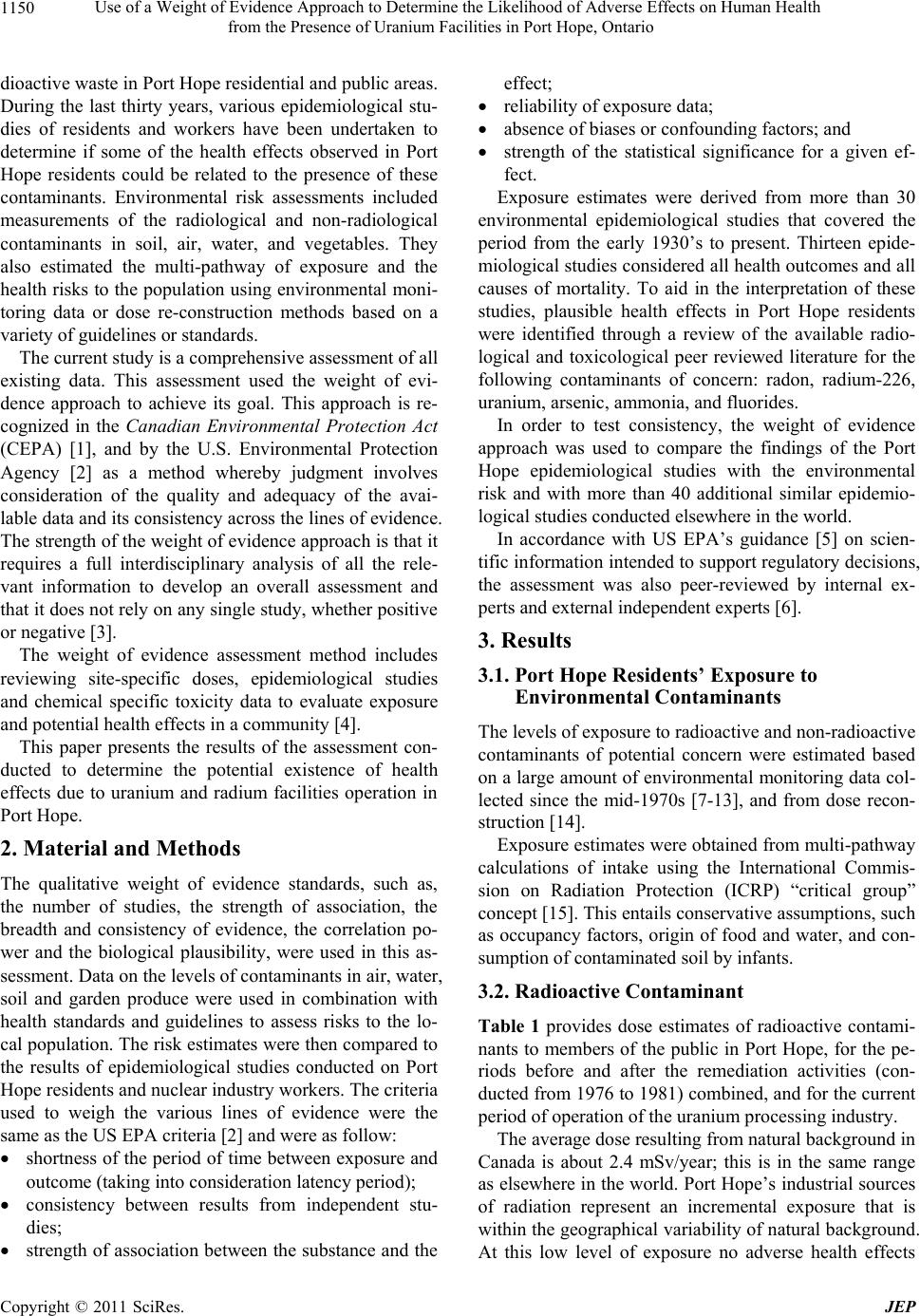 Use of a Weight of Evidence Approach to Determine the Likelihood of Adverse Effects on Human Health 1150 from the Presence of Uranium Facilities in Port Hope, Ontario dioactive waste in Port Hope residential and public areas. During the last thirty years, various epidemiological stu- dies of residents and workers have been undertaken to determine if some of the health effects observed in Port Hope residents could be related to the presence of these contaminants. Environmental risk assessments included measurements of the radiological and non-radiological contaminants in soil, air, water, and vegetables. They also estimated the multi-pathway of exposure and the health risks to the population using environmental moni- toring data or dose re-construction methods based on a variety of guidelines or standards. The current study is a comprehensive assessment of all existing data. This assessment used the weight of evi- dence approach to achieve its goal. This approach is re- cognized in the Canadian Environmental Protection Act (CEPA) [1], and by the U.S. Environmental Protection Agency [2] as a method whereby judgment involves consideration of the quality and adequacy of the avai- lable data and its consistency across the lines of evidence. The strength of the weight of evidence approach is that it requires a full interdisciplinary analysis of all the rele- vant information to develop an overall assessment and that it does not rely on any single study, whether positive or negative [3]. The weight of evidence assessment method includes reviewing site-specific doses, epidemiological studies and chemical specific toxicity data to evaluate exposure and potential health effects in a community [4]. This paper presents the results of the assessment con- ducted to determine the potential existence of health effects due to uranium and radium facilities operation in Port Hope. 2. Material and Methods The qualitative weight of evidence standards, such as, the number of studies, the strength of association, the breadth and consistency of evidence, the correlation po- wer and the biological plausibility, were used in this as- sessment. Data on the levels of contaminants in air, water, soil and garden produce were used in combination with health standards and guidelines to assess risks to the lo- cal population. The risk estimates were then compared to the results of epidemiological studies conducted on Port Hope residents and nuclear industry workers. The criteria used to weigh the various lines of evidence were the same as the US EPA criteria [2] and were as follow: shortness of the period of time between exposure and outcome (taking into consideration latency period); consistency between results from independent stu- dies; strength of association between the substance and the effect; reliability of exposure data; absence of biases or confounding factors; and strength of the statistical significance for a given ef- fect. Exposure estimates were derived from more than 30 environmental epidemiological studies that covered the period from the early 1930’s to present. Thirteen epide- miological studies considered all health outcomes and all causes of mortality. To aid in the interpretation of these studies, plausible health effects in Port Hope residents were identified through a review of the available radio- logical and toxicological peer reviewed literature for the following contaminants of concern: radon, radium-226, uranium, arsenic, ammonia, and fluorides. In order to test consistency, the weight of evidence approach was used to compare the findings of the Port Hope epidemiological studies with the environmental risk and with more than 40 additional similar epidemio- logical studies conducted elsewhere in the world. In accordance with US EPA’s guidance [5] on scien- tific information intended to support regulatory decisions, the assessment was also peer-reviewed by internal ex- perts and external independent experts [6]. 3. Results 3.1. Port Hope Residents’ Exposure to Environmental Contaminants The levels of exposure to radioactive and non-radioactive contaminants of potential concern were estimated based on a large amount of environmental monitoring data col- lected since the mid-1970s [7-13], and from dose recon- struction [14]. Exposure estimates were obtained from multi-pathway calculations of intake using the International Commis- sion on Radiation Protection (ICRP) “critical group” concept [15]. This entails conservative assumptions, such as occupancy factors, origin of food and water, and con- sumption of contaminated soil by infants. 3.2. Radioactive Contaminant Table 1 provides dose estimates of radioactive contami- nants to members of the public in Port Hope, for the pe- riods before and after the remediation activities (con- ducted from 1976 to 1981) combined, and for the current period of operation of the uranium processing industry. The average dose resulting from natural background in Canada is about 2.4 mSv/year; this is in the same range as elsewhere in the world. Port Hope’s industrial sources of radiation represent an incremental exposure that is within the geographical variability of natural background. At this low level of exposure no adverse health effects C opyright © 2011 SciRes. JEP 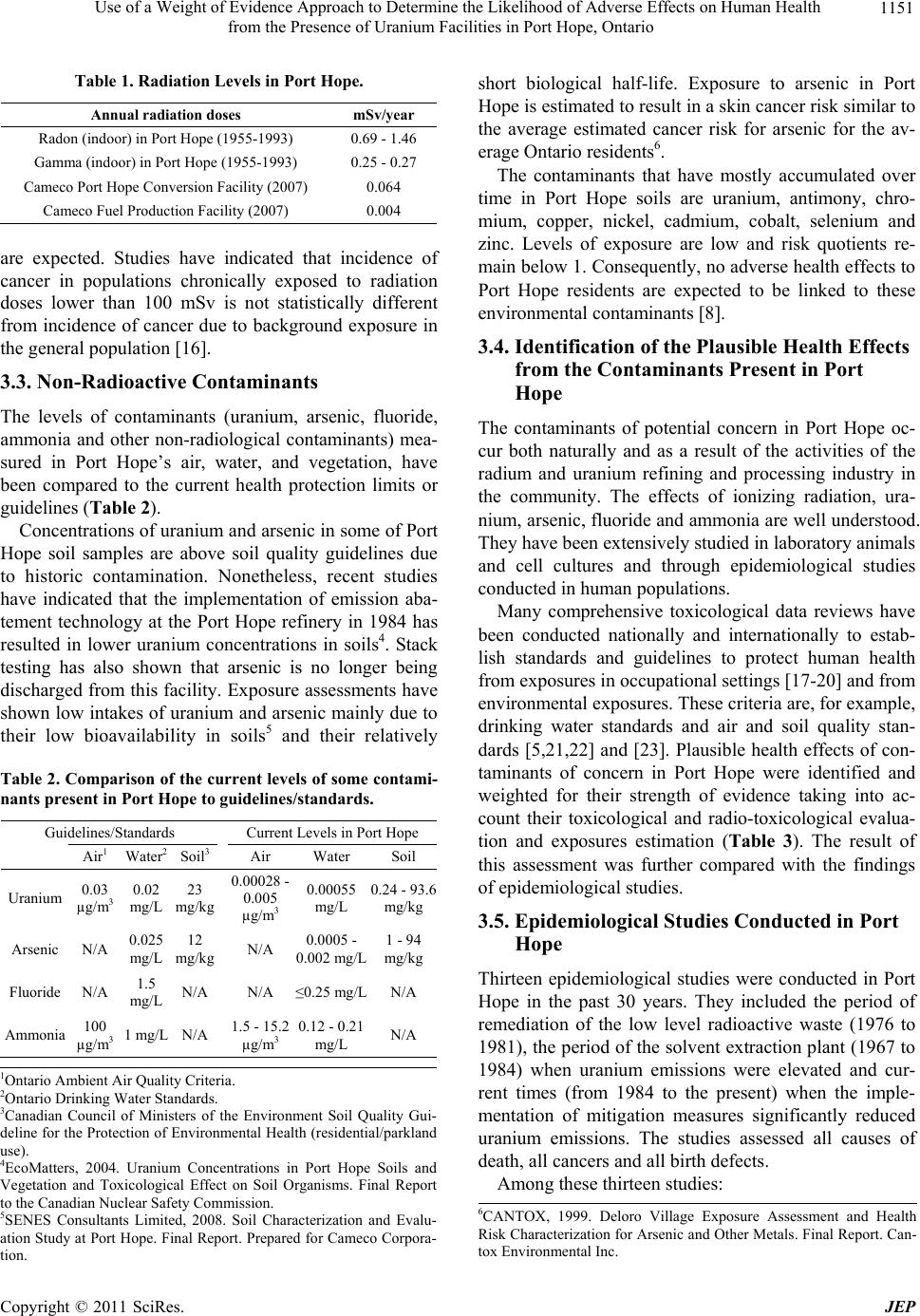 Use of a Weight of Evidence Approach to Determine the Likelihood of Adverse Effects on Human Health 1151 from the Presence of Uranium Facilities in Port Hope, Ontario Table 1. Radiation Levels in Port Hope. Annual radiation doses mSv/year Radon (indoor) in Port Hope (1955-1993) 0.69 - 1.46 Gamma (indoor) in Port Hope (1955-1993) 0.25 - 0.27 Cameco Port Hope Conversion Facility (2007) 0.064 Cameco Fuel Production Facility (2007) 0.004 are expected. Studies have indicated that incidence of cancer in populations chronically exposed to radiation doses lower than 100 mSv is not statistically different from incidence of cancer due to background exposure in the general population [16]. 3.3. Non-Radioactive Contaminants The levels of contaminants (uranium, arsenic, fluoride, ammonia and other non-radiological contaminants) mea- sured in Port Hope’s air, water, and vegetation, have been compared to the current health protection limits or guidelines (Table 2). Concentrations of uranium and arsenic in some of Port Hope soil samples are above soil quality guidelines due to historic contamination. Nonetheless, recent studies have indicated that the implementation of emission aba- tement technology at the Port Hope refinery in 1984 has resulted in lower uranium concentrations in soils4. Stack testing has also shown that arsenic is no longer being discharged from this facility. Exposure assessments have shown low intakes of uranium and arsenic mainly due to their low bioavailability in soils5 and their relatively Table 2. Comparison of the current levels of some contami- nants present in Port Hope to guidelines/standards. Guidelines/Standards Current Levels in Port Hope Air1 Water2 Soil3 Air Water Soil Uranium 0.03 µg/m3 0.02 mg/L 23 mg/kg 0.00028 - 0.005 µg/m3 0.00055 mg/L 0.24 - 93.6 mg/kg Arsenic N/A 0.025 mg/L 12 mg/kg N/A 0.0005 - 0.002 mg/L 1 - 94 mg/kg Fluoride N/A 1.5 mg/L N/A N/A ≤0.25 mg/LN/A Ammonia 100 µg/m3 1 mg/L N/A 1.5 - 15.2 µg/m3 0.12 - 0.21 mg/L N/A short biological half-life. Exposure to arsenic in Port Hope is estimated to result in a skin cancer risk similar to the average estimated cancer risk for arsenic for the av- erage Ontario residents6. The contaminants that have mostly accumulated over time in Port Hope soils are uranium, antimony, chro- mium, copper, nickel, cadmium, cobalt, selenium and zinc. Levels of exposure are low and risk quotients re- main below 1. Consequently, no adverse health effects to Port Hope residents are expected to be linked to these environmental contaminants [8]. 3.4. Identification of the Plausible Health Effects from the Contaminants Present in Port Hope The contaminants of potential concern in Port Hope oc- cur both naturally and as a result of the activities of the radium and uranium refining and processing industry in the community. The effects of ionizing radiation, ura- nium, arsenic, fluoride and ammonia are well understood. They have been extensively studied in laboratory animals and cell cultures and through epidemiological studies conducted in human populations. Many comprehensive toxicological data reviews have been conducted nationally and internationally to estab- lish standards and guidelines to protect human health from exposures in occupational settings [17-20] and from environmental exposures. These criteria are, for example, drinking water standards and air and soil quality stan- dards [5,21,22] and [23]. Plausible health effects of con- taminants of concern in Port Hope were identified and weighted for their strength of evidence taking into ac- count their toxicological and radio-toxicological evalua- tion and exposures estimation (Table 3). The result of this assessment was further compared with the findings of epidemiological studies. 3.5. Epidemiological Studies Conducted in Port Hope Thirteen epidemiological studies were conducted in Port Hope in the past 30 years. They included the period of remediation of the low level radioactive waste (1976 to 1981), the period of the solvent extraction plant (1967 to 1984) when uranium emissions were elevated and cur- rent times (from 1984 to the present) when the imple- mentation of mitigation measures significantly reduced uranium emissions. The studies assessed all causes of death, all cancers and all birth defects. 1Ontario Ambient Air Quality Criteria. 2Ontario Drinking Water Standards. 3Canadian Council of Ministers of the Environment Soil Quality Gui- deline for the Protection of Environmental Health (residential/parkland use). 4EcoMatters, 2004. Uranium Concentrations in Port Hope Soils and Vegetation and Toxicological Effect on Soil Organisms. Final Report to the Canadian Nuclear Safety Commission. 5SENES Consultants Limited, 2008. Soil Characterization and Evalu- ation Study at Port Hope. Final Report. Prepared for Cameco Corpora- tion. Among these thirteen studies: 6CANTOX, 1999. Deloro Village Exposure Assessment and Health Risk Characterization for Arsenic and Other Metals. Final Report. Can- tox Environmental Inc. Copyright © 2011 SciRes. JEP 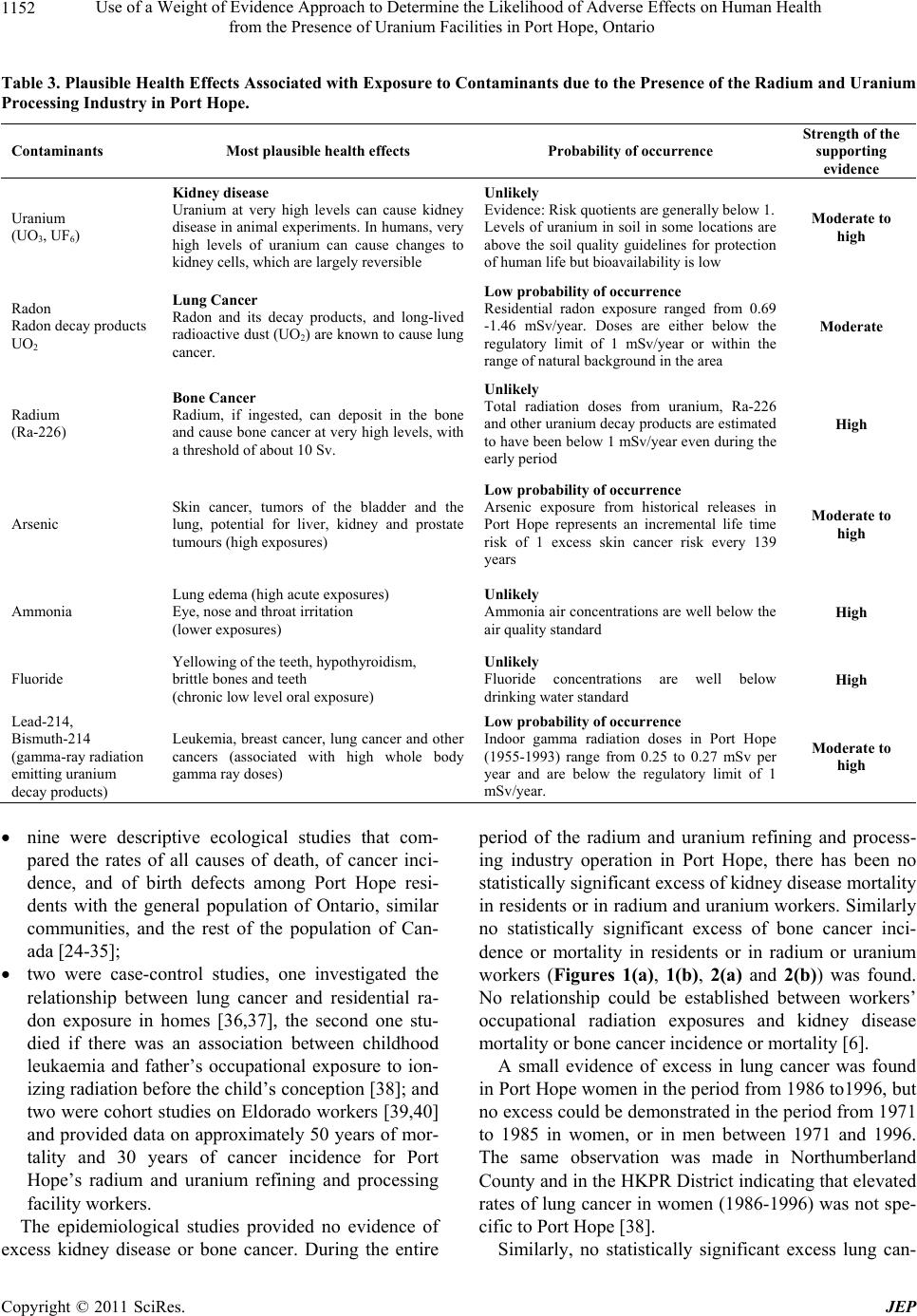 Use of a Weight of Evidence Approach to Determine the Likelihood of Adverse Effects on Human Health from the Presence of Uranium Facilities in Port Hope, Ontario Copyright © 2011 SciRes. JEP 1152 Table 3. Plausible Health Effects Associated with Exposure to Contaminants due to the Presence of the Radium and Uranium Processing Industry in Port Hope. Contaminants Most plausible health effects Probability of occurrence Strength of the supporting evidence Uranium (UO3, UF6) Kidney disease Uranium at very high levels can cause kidney disease in animal experiments. In humans, very high levels of uranium can cause changes to kidney cells, which are largely reversible Unlikely Evidence: Risk quotients are generally below 1. Levels of uranium in soil in some locations are above the soil quality guidelines for protection of human life but bioavailability is low Moderate to high Radon Radon decay products UO2 Lung Cancer Radon and its decay products, and long-lived radioactive dust (UO2) are known to cause lung cancer. Low probability of occurrence Residential radon exposure ranged from 0.69 -1.46 mSv/year. Doses are either below the regulatory limit of 1 mSv/year or within the range of natural background in the area Moderate Radium (Ra-226) Bone Cancer Radium, if ingested, can deposit in the bone and cause bone cancer at very high levels, with a threshold of about 10 Sv. Unlikely Total radiation doses from uranium, Ra-226 and other uranium decay products are estimated to have been below 1 mSv/year even during the early period High Arsenic Skin cancer, tumors of the bladder and the lung, potential for liver, kidney and prostate tumours (high exposures) Low probability of occurrence Arsenic exposure from historical releases in Port Hope represents an incremental life time risk of 1 excess skin cancer risk every 139 years Moderate to high Ammonia Lung edema (high acute exposures) Eye, nose and throat irritation (lower exposures) Unlikely Ammonia air concentrations are well below the air quality standard High Fluoride Yellowing of the teeth, hypothyroidism, brittle bones and teeth (chronic low level oral exposure) Unlikely Fluoride concentrations are well below drinking water standard High Lead-214, Bismuth-214 (gamma-ray radiation emitting uranium decay products) Leukemia, breast cancer, lung cancer and other cancers (associated with high whole body gamma ray doses) Low probability of occurrence Indoor gamma radiation doses in Port Hope (1955-1993) range from 0.25 to 0.27 mSv per year and are below the regulatory limit of 1 mSv/year. Moderate to high nine were descriptive ecological studies that com- pared the rates of all causes of death, of cancer inci- dence, and of birth defects among Port Hope resi- dents with the general population of Ontario, similar communities, and the rest of the population of Can- ada [24-35]; two were case-control studies, one investigated the relationship between lung cancer and residential ra- don exposure in homes [36,37], the second one stu- died if there was an association between childhood leukaemia and father’s occupational exposure to ion- izing radiation before the child’s conception [38]; and two were cohort studies on Eldorado workers [39,40] and provided data on approximately 50 years of mor- tality and 30 years of cancer incidence for Port Hope’s radium and uranium refining and processing facility workers. The epidemiological studies provided no evidence of excess kidney disease or bone cancer. During the entire period of the radium and uranium refining and process- ing industry operation in Port Hope, there has been no statistically significant excess of kidney disease mortality in residents or in radium and uranium workers. Similarly no statistically significant excess of bone cancer inci- dence or mortality in residents or in radium or uranium workers (Figures 1(a), 1(b), 2(a) and 2(b)) was found. No relationship could be established between workers’ occupational radiation exposures and kidney disease mortality or bone cancer incidence or mortality [6]. A small evidence of excess in lung cancer was found in Port Hope women in the period from 1986 to1996, but no excess could be demonstrated in the period from 1971 to 1985 in women, or in men between 1971 and 1996. The same observation was made in Northumberland County and in the HKPR District indicating that elevated rates of lung cancer in women (1986-1996) was not spe- cific to Port Hope [38]. Similarly, no statistically significant excess lung can- 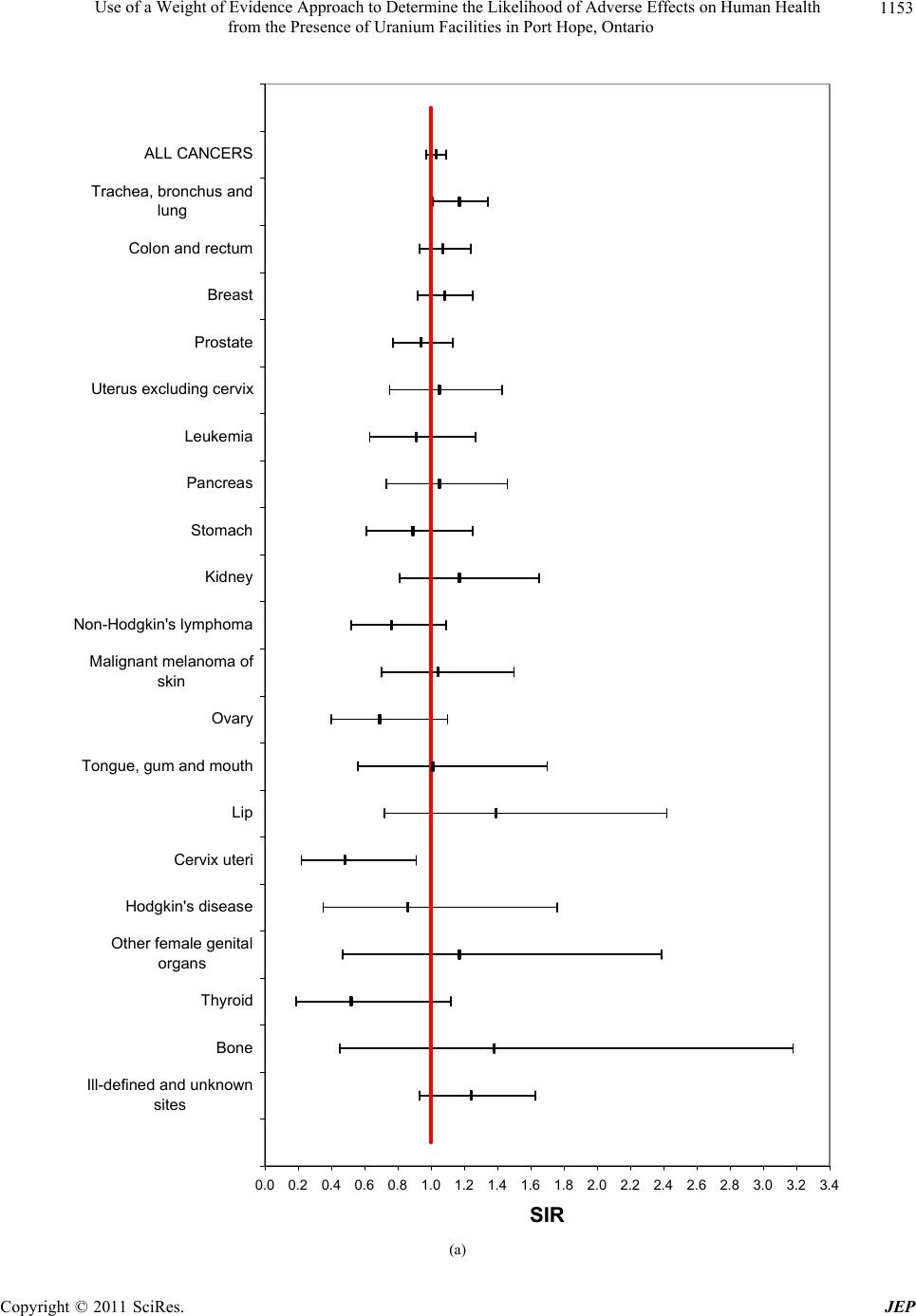 Use of a Weight of Evidence Approach to Determine the Likelihood of Adverse Effects on Human Health 1153 from the Presence of Uranium Facilities in Port Hope, Ontario 0.00.2 0.40.60.8 1.0 1.21.4 1.61.8 2.02.2 2.42.62.8 3.0 3.23.4 ALL CANCERS Trachea, bronchus and lung Colon and rectum Breast Prostate Uterus excluding cervix Leukemia Pancreas Stomach Kidney Non-Hodgkin's lymphoma Malignant melanoma of skin Ovary Tongue, gum and mouth Lip Cervix uteri Hodgkin's disease Other female genital organs Thyroid Bone Ill-defined and unknown sites SIR (a) Copyright © 2011 SciRes. JEP 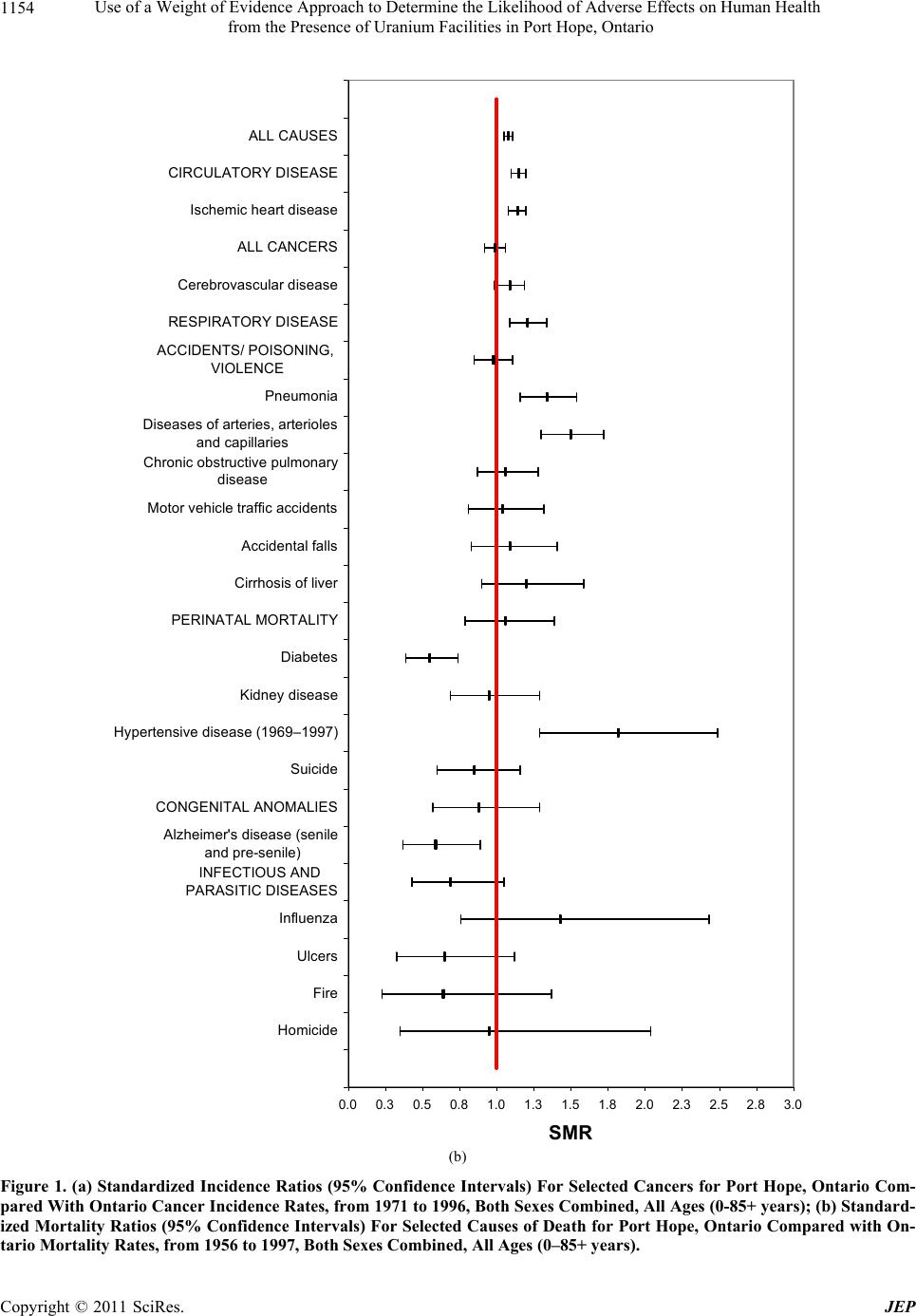 Use of a Weight of Evidence Approach to Determine the Likelihood of Adverse Effects on Human Health 1154 from the Presence of Uranium Facilities in Port Hope, Ontario 0.00.30.50.81.01.31.51.82.02.32.52.83.0 ALL CAUSES CIRCUL ATO RY DISEASE Ischemic heart disease ALL CANCERS Cerebr ov ascular di sea se RESPIR ATO RY DISEASE ACCIDENTS/ POISONING, VIOLENCE Pneumonia Diseases of arteries, arterioles and capillaries Chronic obstructive pulmonary disease Motor vehicle traffic acci dents Accidental falls Cirrhosis of liver PERINATAL MORTALITY Diabetes Kidney disease Hypertensive disease (1969–1997) Suicide CONGENITAL ANOMALIES Alzheimer's disease (senile and pre- senile) INFECTIOUS AND PARASITIC DISEASES Influenza Ulcers Fire Homicide SMR (b) Figure 1. (a) Standardized Incidence Ratios (95% Confidence Intervals) For Selected Cancers for Port Hope, Ontario Com- pared With Ontario Cancer Incidence Rates, from 1971 to 1996, Both Sexes Combined, All Ages (0-85+ years); (b) Standard- ized Mortality Ratios (95% Confidence Intervals) For Selected Causes of Death for Port Hope, Ontario Compared with On- tario Mortality Rates, from 1956 to 1997, Both Sexes Combined, All Ages (0–85+ years). C opyright © 2011 SciRes. JEP 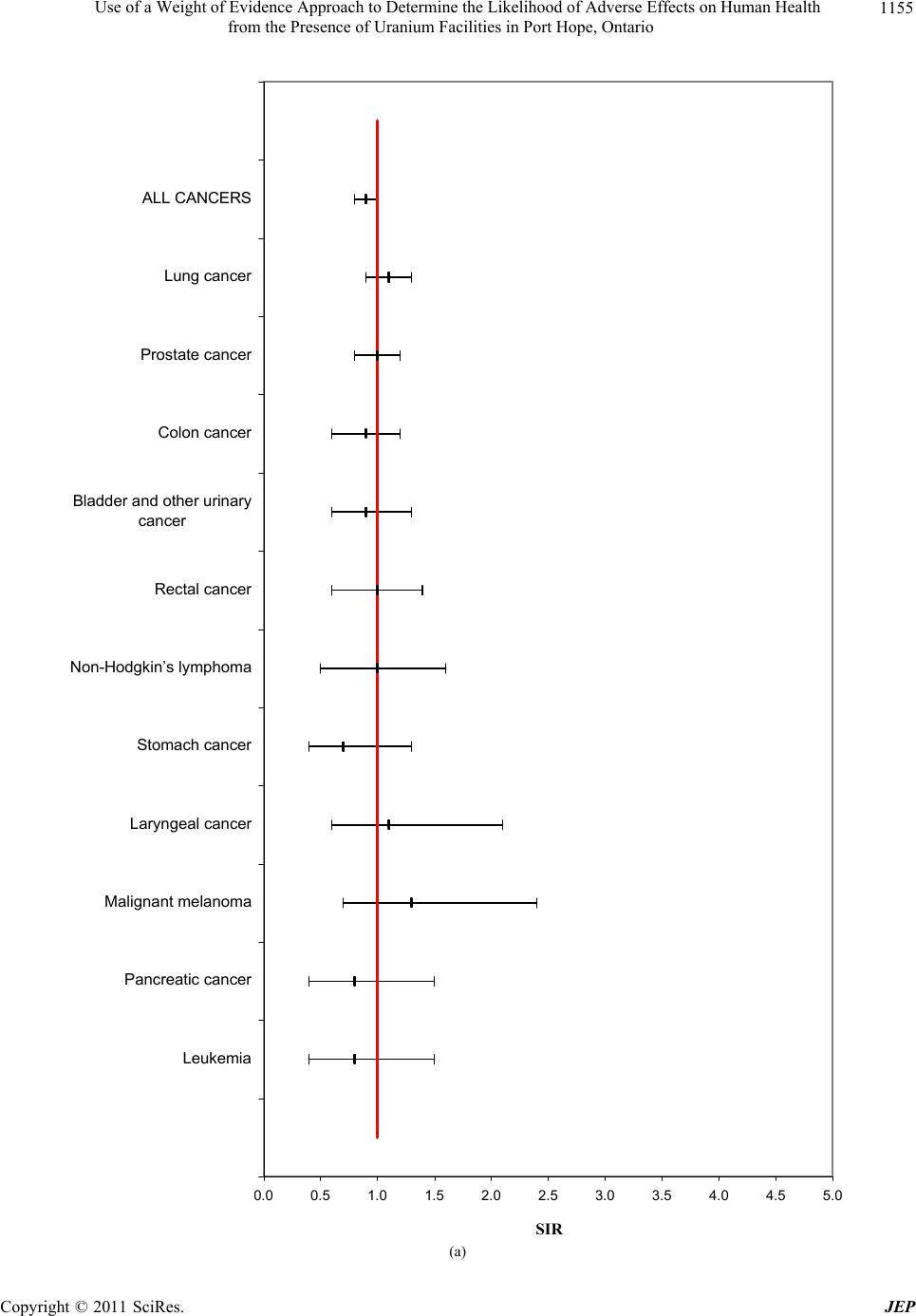 Use of a Weight of Evidence Approach to Determine the Likelihood of Adverse Effects on Human Health 1155 from the Presence of Uranium Facilities in Port Hope, Ontario . . 1. 1. 2. 2. . . 4. 4. . ALL CANCERS Lung cancer Prostate cancer Colon cancer Bladder and other urinary cancer Rectal cancer Non-Hodgkin’s lymphoma Stomach cancer Laryngeal cancer Malignant melanoma Pancreatic cancer Leukemia SIR (a) Copyright © 2011 SciRes. JEP  Use of a Weight of Evidence Approach to Determine the Likelihood of Adverse Effects on Human Health 1156 from the Presence of Uranium Facilities in Port Hope, Ontario 0.0 0.5 1.0 1.5 2.0 2.5 3.0 3.5 4.0 4.5 5.0 ALL CAUSE S Ischemi c he art di sea se ALL CANCERS Lung cance r All other ca rdi ovascul ar di seases Stroke ALL DIGESTIVE DISEASES Pneumonia Other external causes Chronic obstructive lung disease Motor vehicle accident s Colon ca nc er Prostate canc er Genitouri nary diseases Suicide Rectal ca nc er Stomach cancer Diabetes mellitus Hypertensive disease ALL NERVOUS SYSTEM DISEASES Pancreatic canc er Bladder and ot he r urin ary cancer SMR (b) Figure 2. (a) Standardized Incidence Ratios (95% Confidence Intervals- adjusted for age (five year intervals) and calendar year at risk (five year intervals)) For Selected Cancers for Port Hope Eldorado Male Employees Compared With Canadian Male Cancer Incidence Rates, from 1969 to 1999; (b). Standardized Mortality Ratios (95% Confidence Intervals - adjusted for age (five year intervals) and calendar year at risk (five year intervals)) For Selected Cancer Deaths for Port Hope Eldo- rado Male Employees Compared With Canadian Male Mortality Rates from 1950 to 1999. C opyright © 2011 SciRes. JEP  Use of a Weight of Evidence Approach to Determine the Likelihood of Adverse Effects on Human Health from the Presence of Uranium Facilities in Port Hope, Ontario Copyright © 2011 SciRes. JEP 1157 cer incidence or mortality could be observed in Port Hope nuclear workers, and more importantly, there was no statistically significant relationship between workers’ occupational radiation exposures and lung cancer (Table 4). Workers’ average cumulative exposures were 52 mSv for radon and 101.5 mSv for gamma radiation [39] and [40]. Many of these workers were living in the commu- nity which implied they were also exposed to some ra- diation at home. The case-control study conducted in Port Hope [37] on residential radon exposure and lung cancer showed no conclusive evidence of an increased risk of lung cancer in “problem homes” (where annual exposure was above 0.229 Working Level Months or 1.15 mSv per year). In addition, no statistically signifi- cant excess of lung cancer mortality in Port Hope resi- dents for the period from1954 to 1997 [24,25,33] and [6] was demonstrated. Table 5 summarizes the weight of evidence obtained from the various epidemiological studies conducted in Port Hope taking into consideration the robustness of each study; cohort studies being weighted more strongly than case-control and ecological studies. 4. Discussions Taken together, the findings of the 13 epidemiological studies conducted on the general population and the ra- dium and uranium workers support and strengthen the evidence obtained from the risk assessments that adverse health effects are unlikely to be the result of exposure of Port hope residents to environmental contaminants from the radium and uranium processing. 4.1. Circulatory Diseases In the 1956-1997 period, the overall excess of mortality in Port Hope was dominated by an excess of circulatory disease, which represented over 50% of all deaths [33]. Circulatory disease is recognized to be the leading cause of death in Canada [41]. The scientific data available to date are not sufficient to conclude that there is a causal relationship between ionizing radiation exposure and car- diovascular disease for doses lower than 1 to 2 Sv [42]. Given the level of radiation in Port Hope, 0.69 - 1.46 mSv/year from 1967 to 1976 and 0.004 - 0.064 mSv/year in 2007, it is highly unlikely that circulatory diseases could be associated with radiation in the municipality. The excess observed in circulatory diseases is likely mostly due to other risk factors, such as smoking, obesity, physical inactivity, high blood pressure, diabetes, stress and alcohol consumption [43]. The same excess in circulatory disease was found in the whole Northumberland County which confirmed it was not specific to Port Hope. The Rapid Risk Factor Surveillance System (RRFSS) also reported that the overall community (HKPR District) had a high preva- lence of risk factors for circulatory disease, including poor diet, physical inactivity and high rates of cigarette smoking [35]. Meanwhile, Eldorado radium and uranium workers’ overall mortality for all causes of death was ge- nerally comparable with the mortality of the general male population of Canada. 4.2. All Cancers except Lung Cancer Even if increases in some cancers (e.g. colorectal, brain and other nervous system, esophagus, lip, pharynx, nose/ sinuses) could be observed after stratification of the re- sults by age group, sex, time period, and residence cod- ing, it was unlikely that these cancers could be related to activities of the nuclear industry in Port Hope. The lack of biological plausibility and of experimental evidence made it impossible to link them to the presence of con- taminants of concern in Port Hope. The available evidence indicates that colorectal cancer is inducible by high whole-body gamma ray doses, but the risk appears very low at doses lower than 1 Gy [15] [42] and [44]. Ionizing radiation can induce brain and central nervous system tumors, but most of these radia- tion-associated tumors are benign [42]. Cancers of the esophagus, lip, pharynx, nose/sinuses, and lung are most likely linked to tobacco smoking [35,45] and [46]. Other than lung cancer, these cancers are not known to be as- sociated with exposures to environmental contaminants such as those present in Port Hope. Hence, it was not surprising that no relationship was found between these cancers and occupational radiation exposures in the El- dorado workers [39] and [40]. 4.3. Lung Cancer The excess in lung cancer incidence in women observed in one time period (1986 to 1996) in Port Hope is un- likely to be related to environmental contaminants expo- sure since this was not observed during the earlier period [24] and [25] when the level of contaminants was higher; the latency period having been sufficient to have given the disease the opportunity to appear during the earlier period. A temporal relationship is therefore absent. In addition, a case control study conducted in Port Hope [36] and [37] has not been able to establish a con- clusive relationship between residential radon and lung cancer. The levels of residential radon in Port Hope re- mained much lower than those to which radium and ura- nium industry workers were exposed [39] and [40] and the workers did not show any excess in lung cancer inci- dence or mortality. The lack of relationship between lung  Use of a Weight of Evidence Approach to Determine the Likelihood of Adverse Effects on Human Health 1158 from the Presence of Uranium Facilities in Port Hope, Ontario Table 4. Excess Relative Risk Estimates for Lung Cancer Mortality and Incidence due to Radon Decay Products/100 Work Level Months exposure in Port Hope Eldorado Male Employees, 1950-1999 [40]. Lung Cancer Observed ERR Estimate 95% Confidence Interval p-value Mortality (1950-1999) 101 0.18 –0.10, 1.49 0.59 Incidence (1969-1999) 110 0.68 –0.23, 3.07 0.17 Table 5. Strength of evidence of the potential adverse impacts on human health based on the epidemiological studies conducted in Port Hope’s reside nts and in uranium and radium workers. Disease Evidence Description Strength of evidence References Kidney disease No evidence of excess kidney disease - No statistically significant excess kidney disease mortality in Port Hope residents or in radium and uranium workers for the entire period of study. High [24][25] [31] [33] [39] and [40] Little evidence of excess lung cancer No statistically significant excess lung cancer incidence or mortality in Port Hope radium and uranium workers. High [40] and [41] No conclusive evidence of increased lung cancer risk from residential radon exposure in “problem homes” in the case-control study. Moderate [37] No statistically significant excess lung cancer mortality in Port Hope residents from 1956 to 1997. Moderate [32] [33] and [37] Lung cancer Statistically significant excess lung cancer incidence in women in Port Hope from 1986 to1996. No excess was noted during other time periods or in men. Moderate [32] No evidence of excess bone cancer Bone cancer No statistically significant excess bone cancer incidence or mortality in Port Hope residents or radium and uranium workers for the entire period of study. High [32] [33] [39] and [40] No evidence of health effects from occupational exposures Skin cancer and other diseases No statistically significant relationship between workers’ occupational exposures and any cause of death or cancer incidence. High [40] cancer and occupational exposures in these workers pro- vides another line of evidence that environmental radon levels in Port Hope are unlikely to cause lung cancer. 5. Conclusions The findings of the environmental risk assessments and the epidemiological studies conducted in Port Hope are consistent with each other (Tables 3 and 5) and with other epidemiological studies conducted on similar popu- lations elsewhere, [47-57]. Other studies on populations exposed to high concentrations of uranium and radionu- clides in drinking water [58-60] also support this conclu- sion. The weight of evidence approach was used in the cur- rent study to provide a structured framework in order to conduct a transparent interdisciplinary analysis of the numerous health and environmental studies conducted in Port Hope over the last 30 years. By considering all the available lines of evidence and their relative strengths it can be concluded that there is no evidence that adverse health effects have occurred or are likely to occur as a result of the operations of the nuclear industry in the mu- nicipality of Port Hope. REFERENCES [1] “Canadian Environmental Protection Act (CEPA),” Can- ada Gazette Part III, Vol. 22, No. 3, 4 November 1999. http://www.ec.gc.ca/lcpe-cepa/default.asp?lang=En&n=2 4374285-1 [2] U.S. Environmental Protection Agency, “Proposed Guidelines for Carcinogen Risk Assessment,” EPA, Washington EPA/600/P-92/003C, 1996. [3] R. G. Hetes, “Science, Risk, and Risk Assessment and Their Role (s) Supporting Environmental Risk Manage- ment,” Law, Science and the Environment Forum: A Meeting of Minds Lewis and Clark Law School, 19-20 April 2007. [4] Agency for Toxic Substances and Disease Registry C opyright © 2011 SciRes. JEP 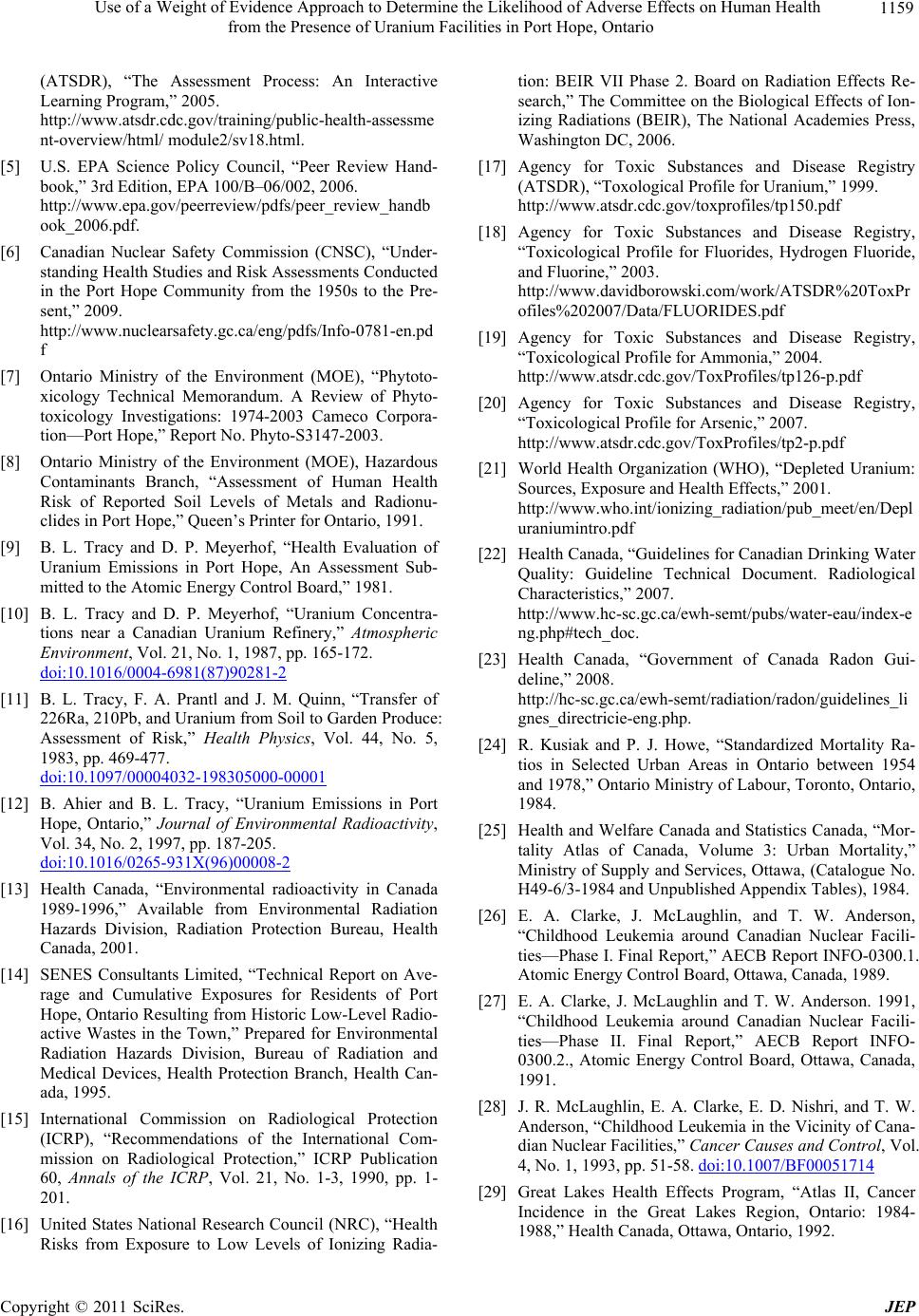 Use of a Weight of Evidence Approach to Determine the Likelihood of Adverse Effects on Human Health 1159 from the Presence of Uranium Facilities in Port Hope, Ontario (ATSDR), “The Assessment Process: An Interactive Learning Program,” 2005. http://www.atsdr.cdc.gov/training/public-health-assessme nt-overview/html/ module2/sv18.html. [5] U.S. EPA Science Policy Council, “Peer Review Hand- book,” 3rd Edition, EPA 100/B–06/002, 2006. http://www.epa.gov/peerreview/pdfs/peer_review_handb ook_2006.pdf. [6] Canadian Nuclear Safety Commission (CNSC), “Under- standing Health Studies and Risk Assessments Conducted in the Port Hope Community from the 1950s to the Pre- sent,” 2009. http://www.nuclearsafety.gc.ca/eng/pdfs/Info-0781-en.pd f [7] Ontario Ministry of the Environment (MOE), “Phytoto- xicology Technical Memorandum. A Review of Phyto- toxicology Investigations: 1974-2003 Cameco Corpora- tion—Port Hope,” Report No. Phyto-S3147-2003. [8] Ontario Ministry of the Environment (MOE), Hazardous Contaminants Branch, “Assessment of Human Health Risk of Reported Soil Levels of Metals and Radionu- clides in Port Hope,” Queen’s Printer for Ontario, 1991. [9] B. L. Tracy and D. P. Meyerhof, “Health Evaluation of Uranium Emissions in Port Hope, An Assessment Sub- mitted to the Atomic Energy Control Board,” 1981. [10] B. L. Tracy and D. P. Meyerhof, “Uranium Concentra- tions near a Canadian Uranium Refinery,” Atmospheric Environment, Vol. 21, No. 1, 1987, pp. 165-172. doi:10.1016/0004-6981(87)90281-2 [11] B. L. Tracy, F. A. Prantl and J. M. Quinn, “Transfer of 226Ra, 210Pb, and Uranium from Soil to Garden Produce: Assessment of Risk,” Health Physics, Vol. 44, No. 5, 1983, pp. 469-477. doi:10.1097/00004032-198305000-00001 [12] B. Ahier and B. L. Tracy, “Uranium Emissions in Port Hope, Ontario,” Journal of Environmental Radioactivity, Vol. 34, No. 2, 1997, pp. 187-205. doi:10.1016/0265-931X(96)00008-2 [13] Health Canada, “Environmental radioactivity in Canada 1989-1996,” Available from Environmental Radiation Hazards Division, Radiation Protection Bureau, Health Canada, 2001. [14] SENES Consultants Limited, “Technical Report on Ave- rage and Cumulative Exposures for Residents of Port Hope, Ontario Resulting from Historic Low-Level Radio- active Wastes in the Town,” Prepared for Environmental Radiation Hazards Division, Bureau of Radiation and Medical Devices, Health Protection Branch, Health Can- ada, 1995. [15] International Commission on Radiological Protection (ICRP), “Recommendations of the International Com- mission on Radiological Protection,” ICRP Publication 60, Annals of the ICRP, Vol. 21, No. 1-3, 1990, pp. 1- 201. [16] United States National Research Council (NRC), “Health Risks from Exposure to Low Levels of Ionizing Radia- tion: BEIR VII Phase 2. Board on Radiation Effects Re- search,” The Committee on the Biological Effects of Ion- izing Radiations (BEIR), The National Academies Press, Washington DC, 2006. [17] Agency for Toxic Substances and Disease Registry (ATSDR), “Toxological Profile for Uranium,” 1999. http://www.atsdr.cdc.gov/toxprofiles/tp150.pdf [18] Agency for Toxic Substances and Disease Registry, “Toxicological Profile for Fluorides, Hydrogen Fluoride, and Fluorine,” 2003. http://www.davidborowski.com/work/ATSDR%20ToxPr ofiles%202007/Data/FLUORIDES.pdf [19] Agency for Toxic Substances and Disease Registry, “Toxicological Profile for Ammonia,” 2004. http://www.atsdr.cdc.gov/ToxProfiles/tp126-p.pdf [20] Agency for Toxic Substances and Disease Registry, “Toxicological Profile for Arsenic,” 2007. http://www.atsdr.cdc.gov/ToxProfiles/tp2-p.pdf [21] World Health Organization (WHO), “Depleted Uranium: Sources, Exposure and Health Effects,” 2001. http://www.who.int/ionizing_radiation/pub_meet/en/Depl uraniumintro.pdf [22] Health Canada, “Guidelines for Canadian Drinking Water Quality: Guideline Technical Document. Radiological Characteristics,” 2007. http://www.hc-sc.gc.ca/ewh-semt/pubs/water-eau/index-e ng.php#tech_doc. [23] Health Canada, “Government of Canada Radon Gui- deline,” 2008. http://hc-sc.gc.ca/ewh-semt/radiation/radon/guidelines_li gnes_directricie-eng.php. [24] R. Kusiak and P. J. Howe, “Standardized Mortality Ra- tios in Selected Urban Areas in Ontario between 1954 and 1978,” Ontario Ministry of Labour, Toronto, Ontario, 1984. [25] Health and Welfare Canada and Statistics Canada, “Mor- tality Atlas of Canada, Volume 3: Urban Mortality,” Ministry of Supply and Services, Ottawa, (Catalogue No. H49-6/3-1984 and Unpublished Appendix Tables), 1984. [26] E. A. Clarke, J. McLaughlin, and T. W. Anderson, “Childhood Leukemia around Canadian Nuclear Facili- ties—Phase I. Final Report,” AECB Report INFO-0300.1. Atomic Energy Control Board, Ottawa, Canada, 1989. [27] E. A. Clarke, J. McLaughlin and T. W. Anderson. 1991, “Childhood Leukemia around Canadian Nuclear Facili- ties—Phase II. Final Report,” AECB Report INFO- 0300.2., Atomic Energy Control Board, Ottawa, Canada, 1991. [28] J. R. McLaughlin, E. A. Clarke, E. D. Nishri, and T. W. Anderson, “Childhood Leukemia in the Vicinity of Cana- dian Nuclear Facilities,” Cancer Causes and Control, Vol. 4, No. 1, 1993, pp. 51-58. doi:10.1007/BF00051714 [29] Great Lakes Health Effects Program, “Atlas II, Cancer Incidence in the Great Lakes Region, Ontario: 1984- 1988,” Health Canada, Ottawa, Ontario, 1992. Copyright © 2011 SciRes. JEP  Use of a Weight of Evidence Approach to Determine the Likelihood of Adverse Effects on Human Health 1160 from the Presence of Uranium Facilities in Port Hope, Ontario [30] Great Lakes Health Effects Program, “Atlas I, Birth De- fects Atlas of Ontario: 1978-1988,” Health Canada, Ot- tawa, Ontario, 1992. [31] Great Lakes Health Effect Program, “Port Hope Harbour Area of Concern: Health Data and Statistics for the Population of the Region (1986-1992), ATechnical Re- port for the RAP Community,” 1998. [32] Health Canada, “Cancer Incidence in Port Hope 1971- 1996. Final Report. CNSC Report INFO-0716,” Canadian Nuclear Safety Commission, Ottawa, Canada, 2000, [33] Health Canada, “Cancer and General Mortality in Port Hope, 1956-1997. Final Report,” CNSC Report INFO- 0734, Canadian Nuclear Safety Commission, Ottawa, Canada, 2002. [34] Haliburton, Kawartha, Pine Ridge (HKPR) District Health Unit, “Cancer in the HKPR District Report,” 2008. http://www.hkpr.on.ca/topics-master.asp?id=3418. [35] Haliburton, Kawartha, Pine Ridge (HKPR) District Health Unit, “Rapid Risk Factor Surveillance System (RRFSS) Survey Results,” 2006. https://www.hkpr.on.ca/index.asp?id=3334. [36] R. E. M. Lees, R. Steele and J. H. Roberts, ‘Study of the Health Effects of Low-Level Exposure to Environmental Radiation Contamination in Port Hope, Ontario,” RA569. 527, 1984. [37] R. E. Lees, R. Steele and J. H. Roberts, “A case control study of lung cancer relative to domestic radon expo- sure,” International Journal of Epidemiology, Vol. 16, No. 1, 1987, pp. 7-12. doi:10.1093/ije/16.1.7 [38] J. R. McLaughlin, W. D. King, T. W. Anderson, E. A. Clarke and P. J. Ashmore, “Paternal Radiation Exposure and Leukemia in Offspring: The Ontario Case-Control Study,” British Medical Journal (BMJ), Vol. 307, No. 6901, 1993, pp. 959-966. doi:10.1136/bmj.307.6910.959 [39] C. Nair, J. D. Abbatt, G. R. Howe, H. B. Newcombe, and S. E. Frost, “Mortality Experience among Workers in the Uranium Industry,” Occupational Radiation Safety in Mining, Toronto, Canadian Nuclear Association Pro- ceedings of the International Conference, Vol. 1, 1984, pp. 354-364. [40] R. S. D. Lane, S. E. Frost, G. R. Howe and L. B. Zablot- ska, “Mortality (1950-1999) and Cancer Incidence (1969- 1999) in the Cohort of Eldorado Uranium Workers,” Ra- diation Research , Vol. 174, No. 6A, 2010, pp. 773-785. doi:10.1667/RR2237.1 [41] Public Health Agency of Canada (PHAC), “Leading Causes of Death and in Canada,” 2004. http://www.phac-aspc.gc.ca/publicat/lcd-pcd97/table1-en g.php [42] United Nations, “Effects of Ionizing Radiation,” Volume I. United Nations Scientific Committee on the Effects of Atomic Radiation, UNSCEAR 2006 Report to the Gene- ral Assembly with Scientific Annexes A and B, United Nations, New York, 2008. [43] Heart and Stroke Foundation, Ontario, “What is Heart Disease?” 2008. http://www.heartandstroke.on.ca/site/c.pvI3IeNWJwE/b.4 007287/k.5D14/What_is_heart_disease.htm [44] International Commission on Radiological Protection (ICRP), “Recommendations of the International Com- mission on Radiological Protection ICRP Publication 103,” Annals of the ICRP, Vol. 37, No. 2-4, 2007, pp. 137-246. [45] Harvard School of Public Health, “Cancer Fact Sheet,” October 2008. http://www.diseaseriskindex.harvard.edu/update/hccpquiz .pl?lang=english&func=home&quiz=lung. [46] American Cancer Society, “Cancer Reference Informa- tion. Detailed Guide: Oral Cavity and Oropharyngeal Cancer,” 2007. http://www.cancer.org/docroot/CRI/content/CRI_2_4_2X _What_are_the_risk_factors_for_oral_cavity_and_oropha ryngeal_cancer_60.asp?sitearea [47] Institute of Medicine (IOM), “Committee on Gulf War and Health: Updated Literature Review of Depleted Ura- nium. Gulf War and Health: Updated Literature Review of Depleted Uranium,” National Academy Press, Wash- ington DC, 2008. [48] The Royal Society, “The Health Hazards of Depleted Uranium Munitions, Part I,” Royal Society, London, 2001. http://royalsociety.org/displaypagedoc.asp?id=11496. [49] The Royal Society, “The Health Hazards of Depleted Uranium Munitions, Part II,” Royal Society, London, 2002. http://royalsociety.org/displaypagedoc.asp?id=11498. [50] J. D. Boice Jr., W. L. Bigbee, M. Mumma and W. J. Blot, “Cancer Incidence in Municipalities near Two Former Nuclear Materials Processing Facilities in Pennsylvania,” Health Physics, Vol. 85, No. 6, 2003, pp.678-690. doi:10.1097/00004032-200312000-00013 [51] J. D. Jr. Boice, M. Mumma and W. J. Blot, “Cancer and Non-Cancer Mortality in Populations Living near Ura- nium and Vanadium Mining and Milling Operations in Montrose County, Colorado, 1950-2000,” Radiation Re- search, Vol. 167, 2007, pp. 711-726. doi:10.1667/RR0839.1 [52] M. Tirmarche, H. Baysson and M. Telle-Lamberton, “Uranium Exposure and Cancer Risk: A Review of Epi- demiological Studies,” Revue d’épidemiologie et de santé publique, Vol. 52, No. 1, 2004, pp. 81-90. [53] J. D. Boice Jr., M. Mumma, S. Schweitzer and W. J. Blot, “Cancer Mortality in a Texas County with Prior Uranium Mining and Milling Activities, 1950-2001,” Journal of Radiological Protection, Vol. 23, 2003, pp. 247-262. doi:10.1088/0952-4746/23/3/302 [54] E. A. Dupree, J. P. Watkins, J. N. Ingle, P. W. Wallace, C. M. West and W. G. Tankersley, “Uranium Dust Exposure and Lung Cancer Risk in Four Uranium Processing Op- erations,” Epidemiology, Vol. 6, No. 4, 1995, pp. 370-375. doi:10.1097/00001648-199507000-00007 C opyright © 2011 SciRes. JEP  Use of a Weight of Evidence Approach to Determine the Likelihood of Adverse Effects on Human Health from the Presence of Uranium Facilities in Port Hope, Ontario Copyright © 2011 SciRes. JEP 1161 [55] J. D. Jr. Boice, R. W. Leggett, E. D. Ellis, et al., “A Comprehensive Dose Reconstruction Methodology for Former Rocketdyne/Atomic International Radiation Workers,” He alth Physics , Vol. 90, No. 5, 2006, pp. 409- 430. doi:10.1097/01.HP.0000183763.02247.7e [56] J. D. Jr. Boice, S. S. Cohen, M. Mumma, B. Chadda and W. J. Blot, “A Cohort Study of Uranium Millers and Miners of Grants, New Mexico, 1979-2005,” Journal of Radiological Protection, Vol. 28, No. 3, 2008, pp. 303- 325. doi:10.1088/0952-4746/28/3/002 [57] J. D. Jr. Boice, M. Mumma, S. Schweitzer and W. J. Blot., “Cancer Mortality in a Texas County with Prior Uranium Mining and Milling Activities, 1950-2001,” Journal of Radiological Protection Vol. 23, 2003, pp. 247-262. doi:10.1088/0952-4746/23/3/302 [58] A. Auvinen, I. Makelainen, M. Hakama, et al., “Indoor Radon Exposure and Risk of Lung Cancer: A Nested Case Control Study in Finland,” Journal of the National Cancer Institute, Vol. 88, No. 14, 1996, pp. 996-972. doi:10.1093/jnci/88.14.966 [59] A. Auvinen, P. Kurttio, J. Pekkanen, et al., “Uranium and Other Natural Radionuclides in Drinking Water and Risk of Leukemia: A Case-Cohort Study in Finland,” Cancer Causes Control, Vol. 13, No.9, 2002, pp. 825-829. doi:10.1023/A:1020647704999 [60] P. Kurttio, A. Harmoinen, H. Saha, et al., “Kidney Toxi- city of Ingested Uranium from Drinking Water,” Ameri- can Journal of Kidney Disease, Vol. 47, No. 6, 2006, pp. 972-982. doi:10.1053/j.ajkd.2006.03.002
|